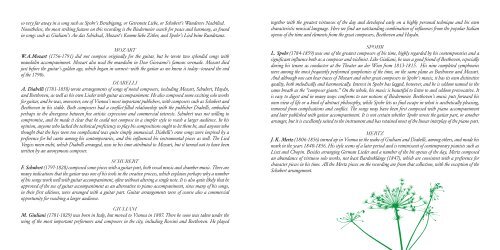Sie wollen auch ein ePaper? Erhöhen Sie die Reichweite Ihrer Titel.
YUMPU macht aus Druck-PDFs automatisch weboptimierte ePaper, die Google liebt.
so very far away in a song such as Spohr’s Beruhigung, or Getrennte Liebe, or Schubert’s Wanderers Nachtlied.<br />
Nonetheless, the most striking feature on this recording is the Biedermeier search for peace and harmony, as found<br />
in songs such as Giuliani’s An das Schicksal, Mozart’s Komm liebe Zither, and Spohr’s Lied beim Rundetanz.<br />
MOZART<br />
W.A.Mozart (1756-1791) did not compose originally for the guitar, but he wrote two splendid songs with<br />
mandolin accompaniment. Mozart also used the mandolin in Don Giovanni’s famous serenade. Mozart died<br />
just before the guitar’s golden age, which began in earnest—with the guitar as we know it today—toward the end<br />
of the 1790s.<br />
DIABELLI<br />
A. Diabelli (1781-1858) wrote arrangements of songs of noted composers, including Mozart, Schubert, Haydn,<br />
and Beethoven, as well as his own Lieder with guitar accompaniment. He also composed some exciting solo works<br />
for guitar, and he was, moreover, one of Vienna’s most important publishers, with composers such as Schubert and<br />
Beethoven in his stable. Both composers had a conflict-filled relationship with the publisher Diabelli, embodied<br />
perhaps in the divergence between free artistic expression and commercial interests. Schubert was not willing to<br />
compromise, and he made it clear that he could not compose in a simpler style to reach a larger audience. In his<br />
opinion, anyone who lacked the technical proficiency to play his compositions ought to let them be, and anyone who<br />
thought that the keys were too complicated was quite simply unmusical. Diabelli’s own songs were inspired by a<br />
preference for bel canto among his contemporaries, and this influenced his instrumental pieces as well. The Lied<br />
Vergiss mein nicht, which Diabelli arranged, was in his time attributed to Mozart, but it turned out to have been<br />
written by an anonymous composer.<br />
SCHUBERT<br />
F. Schubert (1797-1828) composed some pieces with a guitar part, both vocal music and chamber music. There are<br />
many indications that the guitar was one of his tools in the creative process, which explains perhaps why a number<br />
of his songs work well with guitar accompaniment, often without altering a single note. It is also quite likely that he<br />
approved of the use of guitar accompaniment as an alternative to piano accompaniment, since many of his songs,<br />
in their first editions, were arranged with a guitar part. Guitar arrangements were of course also a commercial<br />
opportunity for reaching a larger audience.<br />
GIULIANI<br />
M. Giuliani (1781-1829) was born in Italy, but moved to Vienna in 1807. There he soon was taken under the<br />
wing of the most important performers and composers in the city, including Rossini and Beethoven. He played<br />
together with the greatest virtuosos of the day and developed early on a highly personal technique and his own<br />
characteristic musical language. Here we find an outstanding combination of influences from the popular Italian<br />
operas of the time and elements from the great composers, Beethoven and Haydn.<br />
SPOHR<br />
L. Spohr (1784-1859) was one of the greatest composers of his time, highly regarded by his contemporaries and a<br />
significant influence both as a composer and violinist. Like Giuliani, he was a good friend of Beethoven, especially<br />
during his tenure as conductor at the Theater an der Wien from 1813-1815. His nine completed symphonies<br />
were among the most frequently performed symphonies of the time, on the same plane as Beethoven and Mozart.<br />
And although one can hear traces of Mozart and other great composers in Spohr’s music, it has its own distinctive<br />
quality, both melodically and harmonically. Interest in Spohr has lagged, however, and he is seldom named in the<br />
same breath as the “composer giants.” On the whole, his music is beautiful to listen to and seldom provocative. It<br />
is easy to digest and in many ways conforms to our notions of Biedermeier. Beethoven’s music puts forward his<br />
own view of life or a kind of abstract philosophy, while Spohr lets us find escape in what is aesthetically pleasing,<br />
removed from complications and conflict. The songs may have been first composed with piano accompaniment<br />
and later published with guitar accompaniment. It is not certain whether Spohr wrote the guitar part, or another<br />
arranger, but it is excellently suited to the instrument and has retained most of the linear interplay of the piano part.<br />
MERTZ<br />
J. K. Mertz (1806-1856) turned up in Vienna in the wake of Giuliani and Diabelli, among others, and made his<br />
mark in the years 1840-1856. His style seems of a later period and is reminiscent of contemporary pianists such as<br />
Liszt and Chopin. Besides arranging German Lieder and a number of the hit operas of the day, Mertz composed<br />
an abundance of virtuoso solo works, not least Bardenklänge (1847), which are consistent with a preference for<br />
character pieces in his time. All the Mertz pieces on the recording are from that collection, with the exception of the<br />
Schubert arrangement.








